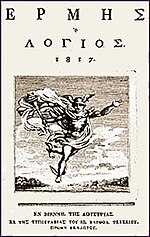
Back تنوير يوناني حديث Arabic Новогръцко просвещение Bulgarian Νεοελληνικός Διαφωτισμός Greek Greka Klerismo Esperanto Ilustración griega Spanish Renaissance culturelle grecque French Nuovo illuminismo greco Italian Новогреческое Просвещение Russian Modern Yunan Aydınlanması Turkish Новогрецьке Просвітництво Ukrainian

The Modern Greek Enlightenment (also known as the Neo-Hellenic Enlightenment;[1] Greek: Διαφωτισμός, Diafotismós / Νεοελληνικός Διαφωτισμός, Neoellinikós Diafotismós) was the Greek expression of the Age of Enlightenment. Greek Enlightenment was an intellectual and philosophical movement that occurred in the Greek community. Most of the Greek people were scattered all over the Ottoman Empire. Some lived on the Ionian Islands, Venice, and other parts of Italy. One of the early proponents of Greek Independence was Leonardos Philaras ironically the Modern Greek enlightenment began shortly after his death. There were constant uprisings throughout the Ottoman Empire countless Greeks lived in Venice and fought for the Venetian Empire against the Ottomans. Some Greek painters living in Venice who fought in the war included: Victor (painter), Philotheos Skoufos, and Panagiotis Doxaras.[2][3] Greek painting dramatically shifted during the Modern Greek Enlightenment. The traditional Byzantine Venetian style that was prevalent in the Cretan School faded in the Heptanese School. Painters such as Doxaras drastically shifted the traditional style. He integrated oil painting, replacing the egg tempera technique.[4][5][6][7][8]
The educational center for the Greek community was Italy where many of the priests were educated and the leadership of the Rum Millet was controlled by Orthodox Christian priests. The education of the Greek community was subjugated by a strict observance of Korydalism which was taught by priests and sanctioned by the Catholic and Orthodox churches. Korydalism was created by Theophilos Corydalleus and it followed Aristotle and Plato's secular philosophical teachings.[9] A central figure in the schism from Korydalism was Methodios Anthrakites who fought to introduce updated European philosophical thought to Greek education. He was persecuted in Constantinople by the church fathers and a debate ensued among Greek scholars during the later part of the 18th century to change education. Nonetheless, Greek priest and astronomer Chrysanthus of Jerusalem had an active relationship with Giovanni Domenico Cassini.[10][11][12]
The American War of Independence sent shockwaves throughout the world and most people demanded liberty or death. Between the date of American independence and the dawn of the Greek War of Independence roughly eleven countries fought for independence beginning with the French War of Independence and eventually The Pamphlet of Rigas Feraios was published in 1797. The pamphlet was an instrument to awaken Greek national consciousness which led to the Greek War of Independence. Another important pamphlet was Hellenic Nomarchy published in 1806 and advocated the ideals of freedom, social justice, and social equality for the Greek people. By 1814, the Filiki Eteria (Society of Friends) formed in Odessa, whose purpose was to overthrow the Ottoman rule of Greece and establish an independent Greek State. Another society called the Philomuse Society was formed with the aim of educating the Greeks and promoting philhellenism.[13]
Eventually, the Greek community fought in the Greek War of Independence for roughly nine years. By the 1830s, the enlightenment struggle continued and the Greek community established a state that was still overshadowed by Orthodox ecclesiastical aristocracy. Orthodox priest Neophytos Vamvas was the dean of the scientific and philosophical school of Athens. Eventually for the proliferation of the people a secular state was preferred and Otto of Greece was elected King. Greek academics studied in Germany and France and a German educational system was implemented in Greece. The major new architecture of Athens was Neoclassical in nature and was a defining characteristic of the Greek Enlightenment and Greek painters represented the Munich School. The Enlightenment movement continued with news of continued Greek oppression among the Greek community living in the Ottoman Empire.[14][15]

Regrettably, slavery still overshadowed the Greek people living in the empire. The Greek slave movement began in the United States with Garafilia Mohalbi and people learned about the horrors of Greek slavery.[16][17] Eventually Hiram Powers sculpted The Greek Slave statue which was exhibited all over the world. The Dance of Zalongo also became a popular movement in art during the Greek Enlightenment and reminded people of the mass suicide of roughly 60 women and children from a cliff in Zalongo in 1803 to avoid capture, enslavement, rape and lifelong torture by Ottoman forces during the Souliote War (1803). The Ottomans implemented the Tanzimat reforms to slow nationalistic sentiment but Greek oppression continued until they were fully liberated and wars ensued for over 100 years. Rhodes, together with the other islands of the Dodecanese, were united with Greece in February 1947.
- ^ Patiniotis M. (2015) "Neo-Hellenic Enlightenment: In Search of a European Identity," in Arabatzis T., Renn J., Simões A. (eds), Relocating the History of Science. Boston Studies in the Philosophy and History of Science, vol 312. Springer, Cham. https://doi.org/10.1007/978-3-319-14553-2_9
- ^ Speake 2021, p. 443.
- ^ Hatzidakis 1987, p. 191.
- ^ Speake 2021, pp. 64, 190, 198, 242, 335, 406 478, 480, 481, 547, 548, 630–631, 649, 683, 692–694, 718, 736, 766–767, 779, 796, 865.
- ^ Drakopoulou 2010, pp. 272–274.
- ^ Kitromilides 2013, pp. 1–60.
- ^ Ricks & Beaton 2016, pp. 1–16.
- ^ Pizanias 2020, pp. 124–174.
- ^ Speake 2021, pp. 405–406.
- ^ Plested 2012, pp. 161–162.
- ^ McGuckin 2011, pp. 364–365.
- ^ Israel 2006, pp. 321–322.
- ^ Speake 2021, p. 1264.
- ^ Savaidou 2010, p. 50.
- ^ Stefanidou 1952, p. 62-66.
- ^ Staff Writers (September 8, 1829). "The Slave Market at Constantinople" (PDF). Vermont Gazette Volume 20 No 39 September 8, 1829 Page 1. Genealogy Bank. Archived (PDF) from the original on March 6, 2024. Retrieved March 26, 2024.
- ^ Demetrios Constantinos Andrianis (October 21, 2022). "Greek Slave Movement". Worldhistories.org. Archived from the original on March 27, 2024. Retrieved March 27, 2024.
© MMXXIII Rich X Search. We shall prevail. All rights reserved. Rich X Search